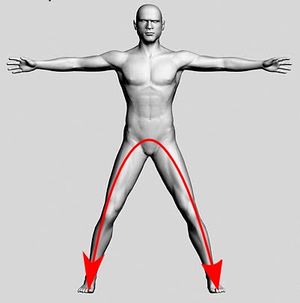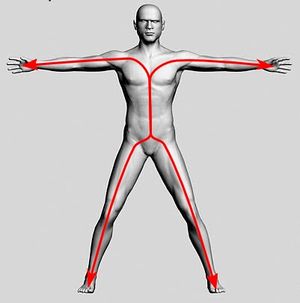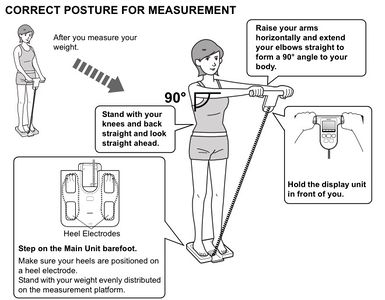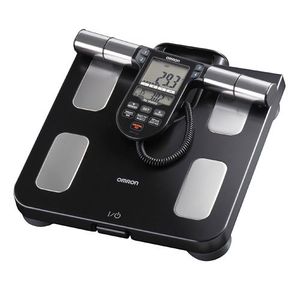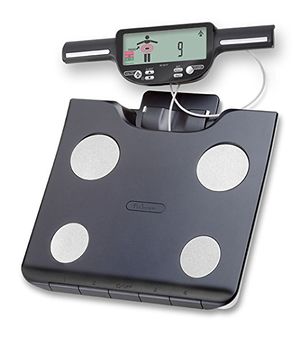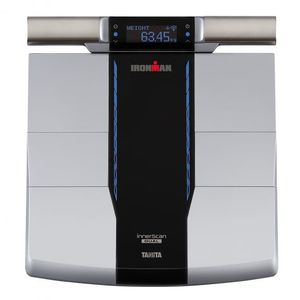Body Fat Scales
Body fat scales can provide a cost-effective and convenient way of measuring body fat. It's best to get fat scales that measure from both the hands and feet, rather than from either the feet or hands alone.
Contents
1 How They Work
Bioelectrical Impedance Analysis (BIA) scales use an imperceptible electrical signal to calculate the amount of water in the body and thus estimate body fat. BIA compares the electrical resistance of a direct current to an alternating current. The direct current does not penetrate the cell walls whereas the alternating current does. This creates a difference that allows an estimate of extracellular water.
1.1 Two or Four Electrodes
BIA scales either have two electrodes that measure from the feet, or four electrodes that measure from both the hands and the feet. You can see in the images below the path electricity takes with scales that measure via feet only compared with when measurements are from the hands and feet. I would not recommend any BIA scales that measure from the feet only. There are also BIA devices that measure from the arms only, but these suffer from similar problems. Error: Could not parse data from Amazon!
1.2 Segmental
Most body fat scales treat the body is a single cylinder with uniform resistance. Unfortunately, because the arms and legs are thinner than the trunk they contributed disproportionate amount of resistance. Typically arms and legs are about 5 to 20% of body weight, but form about half of the overall resistance, while the trunk contains 50% of the body mass and contribute only 5 to 10% of the overall resistance. A segmental scale on the other hand, segments the body up into five cylinders, two for the arms to for the legs and one for the trunk, giving higher accuracy.
1.3 Single or Dual Frequency
Body fat scales use a small, high frequency electrical signal to estimate body fat. It's been known for some time that using more than one frequency can improve accuracy, but consumer grade scales did not support dual frequency until 2017. Typically, the alternating current is around 50 kHz, with dual frequency scales adding in 6.25 kHz for improved accuracy.
2 Accuracy Issues
Hydration can have a significant impact on the reading, so readings need to be taken at the same time of day with the same level of hydration. The 4 Hour Body recommends drinking 1.5 liters (3 pints) of water, waiting 30 minutes, urinating and then taking a measurement. I have found that with the whole body scales I can simply measure when I wake in the morning and I get a consistent enough reading to not require this hydration procedure. The biggest problem for an athlete is that BIA is particularly inaccurate when fat free mass, including Glycogen, changes[1][2]. I've noticed that the day after a long run, the scales claim a much larger loss of body fat than is reasonable. Studies have shown that obesity is underestimated with many body fat scales.
2.1 Optimizing Accuracy
My approach to optimizing my scales accuracy is average and calibrate. My Tanita BC-601 scales offer several activity levels, so I find the level that matches a more accurate body fat measurement such as a DEXA Scan. I then use an average of a week's readings to even out any hydration errors.
2.2 Posture and Accuracy
With BIA scales it's important to get the posture just right, as even small variations in the position of your arms can make a significant change to the reading. You must hold the handset with your arms at 90° with your elbows straight.
3 Recommended Scales
I have tried a number of scales over the years and I believe the Omron HBF-510 is the best value for money, but the Tanita Segmental scales may worth the extra cost for their improved accuracy. I would avoid any scale that only measures via your feet.
3.1 Best Value - Omron HBF-516
The Omron HBF-516 offers great value for money and are one of the cheapest BIA scales that measure from the hands and feet. It's not segmental, so you only get an overall body fat estimate, and it's only single frequency, but it's really cheap. In fact, it's cheaper than a lot of feet-only body fat scales, though unlike Tanita scales, it's not FDA approved. There's no recording of the data, so you'd need to write down the results to track your weight and fitness. There's a 180-day memory, so at least you wouldn't have to do that every day, but I'd still recommend transferring the data to something that will graph your data. Error: Could not parse data from Amazon!. Omron makes a few variants of this scale, such as the HBF-514C Error: Could not parse data from Amazon! (90 day memory), HBF-510W Error: Could not parse data from Amazon! (white, no memory).
3.2 Segmental - Tanita FitScan BC-601FS
The BC-601F is one of the cheaper Tanita single-frequency, segmental BIA scales and it will record your data onto an SD card. This is far less convenient than a Smartphone app, but it's a lot better than writing things down each day. Error: Could not parse data from Amazon!.
3.3 The Best – Tanita RD-545IM
The Tanita RD-545IM is the first consumer grade dual frequency segmental scale. The dual frequency gives increased accuracy, and the RD-545IM even claims to estimate Muscle Quality and measure resting heart rate. Unfortunately, the RD-545IM is not yet released, but should be available soon.
3.4 Comparison Table
| Omron MBF-516 | Tanita BC-601FS | Tanita RD-545IM | |
|---|---|---|---|
| Whole body | Yes | Yes | Yes |
| Segmental | No | Yes | Yes |
| Dual Frequency | No | No | Yes |
| Capacity | 330 Lb | 330 Lb | 440 Lb |
| Weight | Yes | Yes | Yes |
| BMI | Yes | No | Yes |
| Body Fat % | Yes | Yes | Yes |
| Muscle Mass | Yes | Yes | Yes |
| Water % | No | Yes | Yes |
| Bone Mass | No | Yes | Yes |
| Visceral Fat | Yes | Yes | Yes |
| Fat % per limb | No | Yes | Yes |
| Muscle Mass per limb | No | Yes | Yes |
| Muscle Quality | No | No | Yes |
| Data recording | Memory | SD Card | Smartphone App |
4 References
- ↑ Body composition changes assessed by bioelectrical impedance measurements http://www.ncbi.nlm.nih.gov/pubmed/2923071
- ↑ Changes in fat-free mass during weight loss measured by bioelectrical impedance and by densitometry http://www.ncbi.nlm.nih.gov/pubmed/2912008
